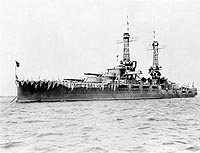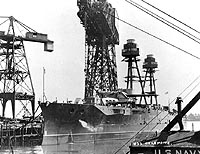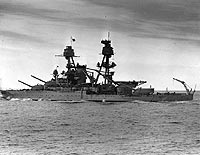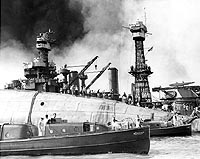
The Nevada class battleships carried the U.S. Navy's first triple gun turrets, a feature that would be seen in all but a few of its future battleship designs. Even more significantly, they introduced the so-called "all or nothing" armor scheme, in which protection of vital areas was optimized against heavy caliber guns, leaving other parts of the ship essentially unprotected. This reflected a growing awareness that improved gunfire controls would drive battleship engagements out to long ranges, where smaller guns would only serve to defend against torpedo and air attack. Thus, armor intended to counter those guns would be, at best, a waste of valuable weight. The basic concept of the Nevadas' armor system was ultimately adopted by all naval powers.
These were also the Navy's first to have oil as their primary fuel and the last to have two propellers. Oklahoma represented the final use of reciprocating machinery. They originally were completed with a very large battery of five-inch guns to defend against enemy destroyers. However, several of those weapons, mounted near the bow and stern in very wet positions, were removed within a few years.
The Nevadas were active in the Atlantic before and during the First World War, deploying to the European war zone in 1918 to help protect Allied supply lines. Their service continued after the "Great War", though by the early 1920s they were the oldest of the Nation's main Battle Fleet units. Both were extensively modernized in 1927-29, receiving greater elevation for their heavy guns, modern gunfire controls in new tripod masts, and two catapults for scouting and observation airplanes. Their 5"/51 anti-destroyer guns were moved to dryer locations in the superstructure and a battery of 5"/25 anti-aircraft guns was added. Protection against shellfire, bombs and torpedoes was improved, increasing their width to nearly 108 feet.
Both ships were sunk in the 7 December 1941 attack on Pearl Harbor, with Nevada's experience proving that the watertight integrity of older warships was unlikely to be satisfactory. Oklahoma was a total loss, but Nevada was salvaged and again modernized during 1942, exchanging her old secondary battery for a new one of twin-mounted 5"/38 guns, plus many 40mm and 20mm anti-aircraft machineguns. She served in both the European and Pacific theaters, providing gunfire support for amphibious operations. Nevada's final mission was as a target for nuclear and conventional weapons in 1946-48.
The Nevada class numbered two ships, both built in
east coast private shipyards:
Nevada class "as-built" design characteristics:
This page features a modest selection of photographs of Nevada class battleships, plus images related to these ships' basic design features, and provides links to more extensive pictorial coverage of the individual ships.
For coverage of other classes of U.S. Navy battleships, see: Battleships -- Overview and Special Image Selection.
| If you want higher resolution reproductions than the digital images presented here, see: "How to Obtain Photographic Reproductions." |
Click on the small photograph to prompt a larger view of the same image.
|
Photo #: NH 44401 USS Oklahoma (BB-37) Photographed circa 1917, while painted in an experimental camouflage pattern. U.S. Naval Historical Center Photograph. Online Image: 61KB; 740 x 590 pixels |
 |
|
Photo #: NH 50109 USS Nevada (BB-36) Steaming with other battleships, during the early 1920s. USS Oklahoma (BB-37) is in the left background. The other ship is either USS Pennsylvania (BB-38) or USS Arizona (BB-39). Photographed by A.E. Wells, Washington, D.C. U.S. Naval Historical Center Photograph. Online Image: 66KB; 740 x 540 pixels |
 |
|
Photo #: NH 74634 USS Oklahoma (BB-37) Undergoing modernization at the Philadelphia Navy Yard, circa 1928. Installation of her new tripod masts is well along, but the rest of her superstructure must still be fitted. Donation of Lieutenant Gustave Freret, USN (Retired), 1971. U.S. Naval Historical Center Photograph. Online Image: 122KB; 740 x 595 pixels |
 |
|
Photo #: NH 97395 USS Nevada (BB-36) Operating at sea, during the later 1930s, with her 14"/45 main battery guns trained on her port bow. Donation of Edwin C. Finney, Jr., 2000. Official U.S. Navy Photograph, from the collections of the Naval Historical Center. Online Image: 94KB; 740 x 600 pixels |
 |
|
Photo #: 80-G-19941 Pearl Harbor Attack, 7 December 1941 Rescue teams at work on the capsized hull of USS Oklahoma (BB-37), seeking crew members trapped inside, 7 December 1941. The starboard bilge keel is visible at the top of the upturned hull. Officers' Motor Boats from Oklahoma and USS Argonne (AG-31) are in the foreground. USS Maryland (BB-46) is in the background. Official U.S. Navy Photograph, now in the collections of the National Archives. Online Image: 99KB; 740 x 615 pixels Reproductions of this image may also be available through the National Archives photographic reproduction system. |
 |
|
Photo #: 80-G-282709 USS Nevada (BB-36) Underway off the U.S. Atlantic coast, 17 September 1944. Photographed from a blimp of squadron ZP-12. Official U.S. Navy Photograph, now in the collections of the National Archives. Online Image: 150KB; 740 x 580 pixels Reproductions of this image may also be available through the National Archives photographic reproduction system. |
 |
|
Photo #: 80-G-252412 Normandy Invasion, June 1944 Forward 14"/45 guns of USS Nevada (BB-36) fire on positions ashore, during the landings on "Utah" Beach, 6 June 1944. Official U.S. Navy Photograph, now in the collections of the National Archives. Online Image: 90KB; 740 x 605 pixels Reproductions of this image may also be available through the National Archives photographic reproduction system. |
 |
For more views of Nevada class battleships, see:
For coverage of other classes of U.S. Navy battleships, see: Battleships -- Overview and Special Image Selection.
| If you want higher resolution reproductions than the digital images presented here, see: "How to Obtain Photographic Reproductions." |
Page made 29 October 2000
Coding updated 26 March 2001